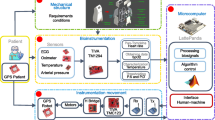Abstract
The advent of VLSI technology brings in its wake huge benefits to patients, doctors and designers, undreamt before, by bringing in automation and raising the level of care nurses are able to provide. Instead of walking to each patient’s bedside to collect vital information, nurses can collect it in one location and concentrate their efforts on caring for those who need them the most. As an outcome of these requirements, a prospect arose to design a highly efficient patient care and monitoring system which can handle patients and multiple parametric measurements from every single patient in real time. Patient care and monitoring embedded systems are proposed in this work to acquire, store, display physiological information obtained from multi patients and are vital in operating rooms, emergency rooms, intensive care units, ambulances as well as at homes. The design exploits development of Novel, Fast Algorithms, Design of Architectures using labVIEW implementations.
Access this chapter
Tax calculation will be finalised at checkout
Purchases are for personal use only
Similar content being viewed by others
References
Ives, T.G., Kampmann, J.R., Pastor, F., Pascual-Leone, M.A.: A new device and protocol for combining TMS and online recordings of EEG and evoked potentials. J. Neurosci. Methods 141(2), 207–217 (2005 Feb)
Di, W., Zhu, D.: Study on brain fag based on EEG signal analysis. In: 2009 ETP International Conference on Future Computer and Communication, Wuhan, China, pp. 134–137, June 2006
Zhuang, X., Sekiyama, K., Fukuda, T.: Evaluation of human sense by biological information analysis. In: International symposium on Micro-NanoMechatronics and Human Science, Nagoya, Japan, pp. 74–79, Nov 2009
Guçluturk, Y., Guçlu, U., Samraj, A.: An online single trial analysis of the P300 event related potential for the disabled. In: IEEE 26th Convention of Electrical and Electronics Engineers, Eliat, Israel, pp. 338–341, Nov 2010
Website: http://www.NI.Com
Kaper, M., Ritter, H.: Generalizing to new subjects in brain-computer interfacing. In: Proceedings of the 26 Annual Conference of the IEEE EMBS, San Francisco, USA, pp 4363–4366, Sept 2004
Harun, H., Mansor, W.: EOG signal detection for home appliances activation. In: 5th International Colloquium on Signal Processing & Its Applications (CSPA), Kuala Lumpur, Malaysia, pp. 195–197, Mar 2009
Kirbis, M., Kramberger, I.: Multi channel EOG signal recognition for an embedded eye movement tracking device. In: 16th International conference on Systems, Signals and Image Processing, IWSSIP, Chalkida, pp. 1–4, June 2009
Lin, M., Li, B.: A wireless EOG-based human computer interface. In: 3rd International Conference on Biomedical Engineering and Informatics, Yantai, Japan, vol. 5, pp. 1794–1796, Oct 2010
Matsuoka, Y., Afshar, P., Oh, M.: On the design of robotic hands for brain–machine interface. Neurosurg. Focus 20(5), 1–9 (2006 May)
Huang, H.-P., Hsu, L.-P.: Development of a wearable biomedical heath-care system. In: International Conference on Intelligent Robots and System, Taipei, Taiwan, pp. 1760–1765, August 2005
Isais, R., Nguyen, K., Perez, G., Rubio, R., Nazeran, H.: A low-cost microcontroller-based wireless ECG-blood pressure telemonitor for home care. In: Proceedings of the 25th Annual International Conference of the IEEE Engineering in Medicine and Biology Society IEEE, vol. 4, pp. 3157–3160, Sept 2003
Bobbie, P.O., Chaudhari, H., Ari, C.-Z.: Homecare telemedicine: analysis and diagnosis of tachycardia condition in an M8051 microcontroller. In: IEEE/EMBS International Summer School on Medical Devices and Biosensors (ISSS-MD), Hongkong, pp. 47–52, Sept 2006
Milea, P.L., Stefan, G., Moga, M., Barbilian, A., Mitulescu, S., Cernat, E., Oltu, O., Moldovan, C., Pompilian, S.: Hardware and software package for locomotory disabled patients training. Int. J. Syst. Appl. Eng. Dev. 5(3) (2011)
Author information
Authors and Affiliations
Corresponding author
Editor information
Editors and Affiliations
Rights and permissions
Copyright information
© 2020 Springer Nature Switzerland AG
About this paper
Cite this paper
Mamatha, M.N. (2020). Design of Single Patient Care Monitoring System and Robot. In: Auer, M., Ram B., K. (eds) Cyber-physical Systems and Digital Twins. REV2019 2019. Lecture Notes in Networks and Systems, vol 80. Springer, Cham. https://doi.org/10.1007/978-3-030-23162-0_19
Download citation
DOI: https://doi.org/10.1007/978-3-030-23162-0_19
Published:
Publisher Name: Springer, Cham
Print ISBN: 978-3-030-23161-3
Online ISBN: 978-3-030-23162-0
eBook Packages: Intelligent Technologies and RoboticsIntelligent Technologies and Robotics (R0)




